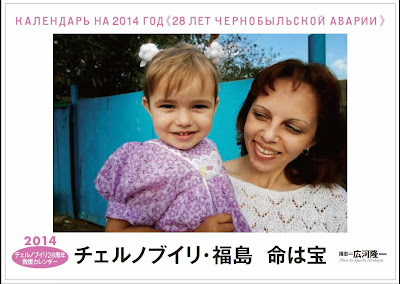The 2014 Calendar for Children in Chernobyl and Fukushima (28th Anniversary) consists of pictures of children in Chernobyl and Fukushima who are spending time at
sanatoriums. The following photo for the month of March shows children from Fukushima who are
playing energetically with their hands and feet in the sand without caring about radiation. Some
of them were born after March 11, so it is the first time for them to enjoy the
ocean.
The Chernobyl
Children’s Fund has supported the people in the devastated area of Chernobyl since
1991, and it has made a charity calendar every year since 1996. After the
nuclear accident at Fukushima on March 11, 2011, the foundation received many
responses from people in Chernobyl, well-wishing the children in Japan. The 2013 and 2014 Calendar
for Children in Chernobyl include pictures and poems written by children in Chernobyl and Fukushima.
Besides the calendar, the Funds also sells postcards, books and so on. The proceeds are used for
medical and relief expenses for children.
Price: 1000 yen
Mailing Cost: 100
yen (up to 2 copies)
Actual price (3 to 9 copies)
Free shipping (more than 10 copies)
Payment: Postal
Transfer
(Name of the Account) Chernobyl Children's Fund, Japan
(Postal Transfer Number) 00160-4-98316 (Transfer in Japan)
☆The Chernobyl Children Fund☆
Fouder/Adviser HIROKAWA Ryuichi
Email: cherno1986@tokyo.email.ne.jp
URL: http://homepage2.nifty.com/chernobyl_children/index-e.html
Office: 207 Maison de Hara, 25 Shirogane-cho, Shinjuku-ku,
Tokyo 162-0816 Japan
Tel /Fax: 81-3-5228-2680
(Name of the Account) Chernobyl Children's Fund, Japan
(Postal Transfer Number) 00160-4-98316 (Transfer in Japan)
☆The Chernobyl Children Fund☆
Fouder/Adviser HIROKAWA Ryuichi
Email: cherno1986@tokyo.email.ne.jp
URL: http://homepage2.nifty.com/chernobyl_children/index-e.html
Office: 207 Maison de Hara, 25 Shirogane-cho, Shinjuku-ku,
Tokyo 162-0816 Japan
Tel /Fax: 81-3-5228-2680
☆HIROKAWA Ryuichi Photo Exhibition Office☆
Since April 1991 photo exhibitions have been held at more than 700 different places in Japan. From May 1997 pictures drawn by Chernobyl children are also lent out for exhibitions. (From the Fund's website)
Original Article on the WAN Website (November 26, 2013)
Translated and Adapted by Naoko Uchibori




